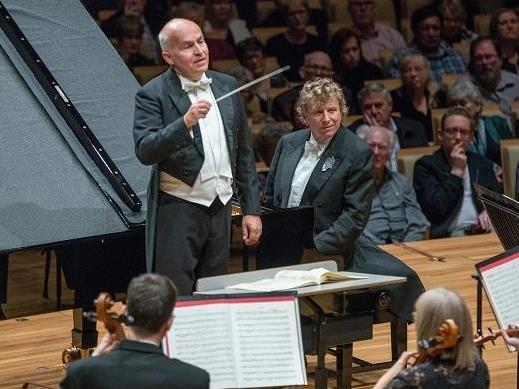Maestro Johannes Fritzsch and soloist Piers Lane. Image: Peter Wallis.
One of the major Maestro concerts of the year, the Queensland Symphony Orchestra’s Cathedral of Sound featured two important works in the musical canon that fully delivered on the subtitle, ‘Epic Musical Landscapes’.
Among the many sublime piano concertos composed by Mozart, the No.23 in A is possibly the finest. It is so well-loved and well-known that its very choice can be risky for an orchestra or soloist, as any rendition must be near perfect to impress. Musically flawless, the melodies leap off the page offering a soundscape that encompasses not only the lushness of the orchestra but also the unique voices of individual instruments, including the virtuosic piano, to offer a totally satisfying experience.
Both Maestro Johannes Fritzsch and soloist Piers Lane wisely did not try to reinterpret or stamp their personalities on Mozart’s work. Rather they allowed the ravishing music to speak for itself in an unshowy but technically precise reading, impressively and carefully delivered. Both the strings, and in particular the woodwinds of flute, clarinet and bassoon, were featured to great effect in their short interjections with the piano, framed within Mozart’s colourful musical palette.
A consummate performer and musician, pianist Lane approached the work briskly and joyously, his expert technical proficiency assured in its delivery. Building intensity throughout the Allegro movement, he gave a confident and passionate reading of the cadenza, with some brilliant well-placed arpeggios. The Adagio started with slower than usual tempi but it worked beautifully with Lane’s delicate finger work brushing lightly across the keyboard, evoking a sparkling dexterity. The final Allegro Assai movement was taken at a very fast pace by Lane, the swift, jaunty music and woodwind solos sometimes just behind his speed. Nevertheless, it was a strong and exhilarating musical ride showcasing Mozart’s glorious melodies with style and skill.
Bruckner’s Symphony No.7 is generally regarded as his finest work but is rarely performed due to the large orchestral forces required and the need for special instruments. A cross between the French horn and the trombone, the Wagner tubas were originally created for The Ring Cycle. Four French horn players took on these instruments in the concert, deserving of special commendation for their skills and control.
From the outset Johannes Fritzsch, Conductor Laureate of the QSO, commanded the orchestra with a quiet yet controlled confidence, well able to draw out from his players both technical assurance and a beautiful sonority. Implicitly understanding this music, he shifted from the Allegro’s opening sweeping lyricism through a range of complex themes, mood shifts and colourful soundscapes in both the Adagio and Scherzo movements to a Finale filled with hope, longing and a sense of purpose.
Fritzsch managed mood and theme swings with aplomb and verve. The full strings that opened the Allegro movement gave way to some dazzling brass and the woodwind solos, with the darker strings taking a predominant role in the delivery. Each section was well-served by the Conductor, rising well to meet the challenge. It helped to have the double basses at the back of the orchestra above the brass, where they could be both prominently seen and heard. The movement fluctuated between bright breezy episodes and dark heavy instrumentation with a cacophony of sounds that led to an explosive conclusion.
The Adagio is possibly Bruckner’s most famous movement, due to the Coda with its homage to Wagner. Here the tubas came into their own, with a mournful sweetness in the music that became achingly dark and brooding. The repeated deep notes from the brass gave us some marvellous depth to the chilling music, beautifully played.
The chirpy and exuberant Scherzo movement with its light, fast rhythms offered a major contrast to the Adagio, aided by the brilliant repetitive notes from the first trumpet and an exciting change of musical pace. The Finale, with its marching strings and four distinctively different musical sections, gave us more Wagner tubas and some lovely solos from the first violin in particular, with a spectacular resolution that involved ferocious playing from the double basses.
In every respect this was a terrific concert, with a choice of two remarkable works played with confidence and panache. Assisted by masterly conducting from the QSO’s Conductor Laureate and with the addition of Queenslander and international concert pianist, Piers Lane, in a polished performance of Mozart’s splendid Piano Concerto No.23, orchestral concerts rarely get much better than this.
4.5 stars out of 5 ★★★★☆
Cathedral of Sound
Queensland Symphony Orchestra
Conductor: Johannes Fritzsch
Soloist: Piers Lane, piano
11 May 2019
Concert Hall, Queensland Performing Arts Centre
Tickets $49-$119





